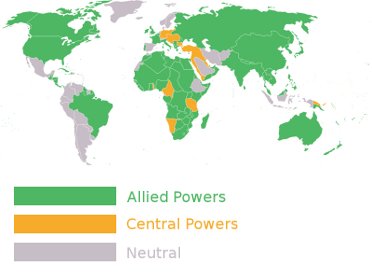What Countries Were Involved in World War I

Triple Entente Vs Central Powers
World War I was the second deadliest military conflict in history after World War II. It involved more than two thirds of the world assembled in two military alliances both of which were formed before the outbreak of the war – the Triple Entente or the Allies on the one hand and the Central Powers on the other. The key members of the Triple Entente were France, Russia and Great Britain, while the original members of the Central Powers were the German Empire and Austria-Hungary.
European Conflict Evolves into World War
World War I started with the Austro-Hungarian declaration of war on Serbia on July 28, 1914. It began as a European military conflict but it involved countries from all the continents by the end of 1914 when the European armies were joined by the forces from their colonies, dominions, protectorates and occupied territories. Only few states remained neutral during the entire World War I.
Countries that Fought on the Allied Side
The Allies that supported Serbia were eventually joined by the following countries (by alphabetical order): Aden Protectorate (former South Yemen), Andorra, Arabia (Saudi Arabia, Iraq, Jordan, Syria and Lebanon), Australia, Belgium, Bolivia, Borneo, Brazil, Canada, China, Costa Rica, Cuba, Cyprus, Ecuador, French Indochina (today’s Cambodia, Laos and Vietnam), French Guiana, Greece, Guatemala, Guyana, Haiti, Honduras, Indian Empire or British Raj (including India, Bangladesh, Burma and Pakistan), Italy, Japan, Malta, Montenegro, Muscat and Oman (today’s Sultanate of Oman and parts of the United Arab Emirates), Newfoundland, New Zealand, Nicaragua, Panama, Peru, Philippines, Portugal, Romania, San Marino, Siam (today’s Thailand), Trucial States (today’s United Arab Emirates) the United States, Uruguay and all African countries except for Western Sahara and Ethiopia that remained neutral, and the German East Africa (today’s Burundi, Rwanda and Tanganyika), German South West Africa (today’s Namibia), Togo and Cameroon which fought on the side of the Central Powers.
Countries that Joined the Central Powers
In addition to the above mentioned African countries and the German territories in the Pacific (Kiautschou Bay in China, German New Guinea, Bismarck Archipelago, Marshall Islands, Mariana Islands, Caroline Islands and German Samoa), the German Empire and Austria-Hungary managed to gain on their side only the Ottoman Empire and Bulgaria. Italy entered the war on the side of the Allies despite the fact that it was in a military alliance with Germany and the Dual Monarchy since 1882. The Germans also failed to draw Mexico into the war by offering the United States territory in return. In addition, the British intercepted and deciphered the so-called Zimmermann Telegram containing the German proposition in January 1917 and revealed the note’s content to the Americans.
Neutral States
A few countries did not get involved in World War I. Some of them traded with both sides, some were occupied, while the others secretly or openly supported one side against the other. Countries that were neutral during World War I were: Afghanistan, Albania, Argentina, Chile, Colombia, Denmark, El Salvador, Ethiopia, Iceland, Indonesia, Liechtenstein, Luxembourg, Mexico, the Netherlands, Norway, Paraguay, Persia (Iran), Spain, Suriname, Sweden, Switzerland, Venezuela and Western Sahara.




